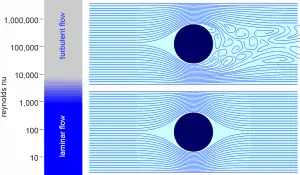Single-phase Fluid Flow
The classic study of fluid dynamics concentrates on the flow of a single homogeneous phase, e.g.,, water, air, steam. The fluid flow equations and relationships normally discussed in this section are for the flow of a single phase of fluid, whether liquid or vapor.
When the simultaneous flow of liquid and gas occurs at certain important locations in fluid flow systems, the problem must be solved as a two-phase flow. The relatively simple relationships used for analyzing single-phase flow are insufficient for analyzing two-phase flow.
Two-phase Fluid Flow
By definition, multiphase flow is the interactive flow of two or more distinct phases with common interfaces in, say, a conduit. Each phase, representing a volume fraction (or mass fraction) of solid, liquid, or gaseous matter, has its own properties, velocity, and temperature.
A multiphase flow can be a simultaneous flow of:
- Materials with different states or phases (e.g.,, water-steam mixture).
- Materials with different chemical properties but in the same state or phase (e.g.,, oil droplets in water).
There are many combinations in industrial processes, but the most common being the simultaneous flow of steam and liquid water (as encountered in steam generators and condensers). In reactor engineering, a great deal of study has been performed on the nature of two-phase flow in case of a loss-of-coolant accident (LOCA), an accident of importance in reactor safety, and all thermal-hydraulic analyses (DNBR analyses).
Characteristics of Multiphase Fluid Flow
All multiphase flow problems have features that are characteristically different from those found in single-phase problems.
- In the case of steam and liquid water, the density of the two phases differs by a factor of about 1000. Therefore the influence of gravitational body force on multiphase flows is of much greater importance than in the case of single-phase flows.
- The sound speed changes dramatically for materials undergoing a phase change and can be orders of magnitude different. This significantly influences a flow through an orifice.
- The relative concentration of different phases is usually a dependent parameter of great importance in multiphase flows, while it is a parameter of no consequence in single-phase flows.
- The phase change means flow-induced pressure drops can cause further phase change (e.g.,, water can evaporate through an orifice), increasing the relative volume of the gaseous, compressible medium and increasing efflux velocities, unlike single-phase incompressible flow where decreasing of an orifice would decrease efflux velocities.
- The spatial distribution of the various phases in the flow channel strongly affects the flow behavior.
- There are many types of instabilities in multiphase flow.
